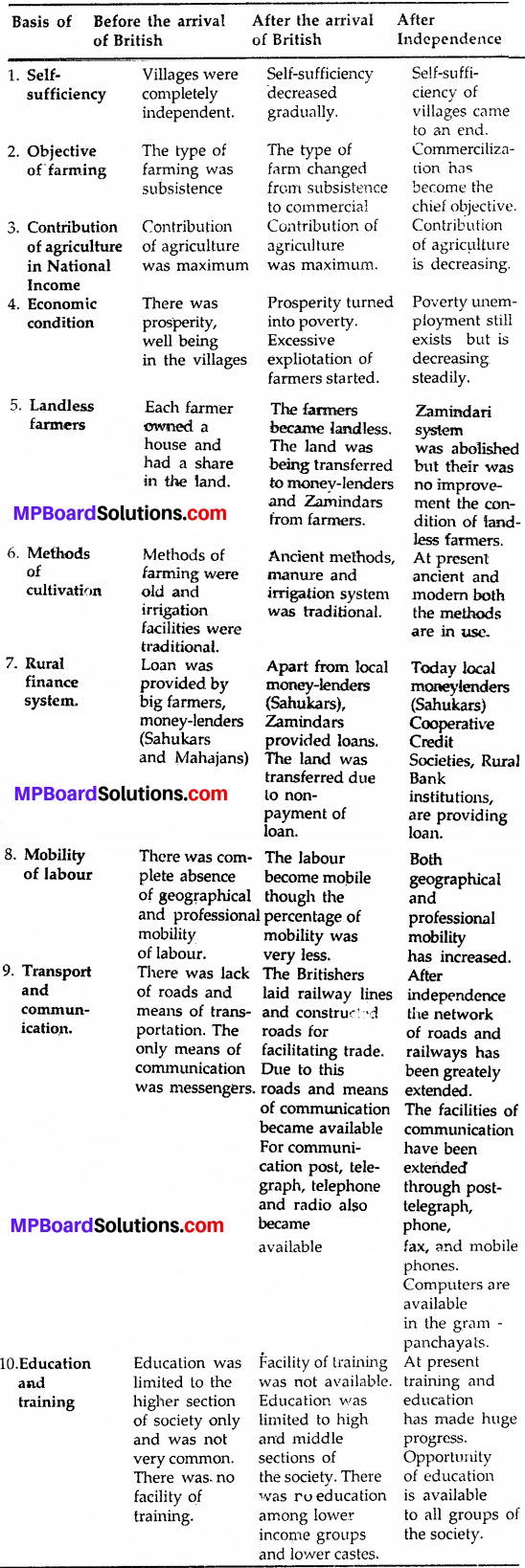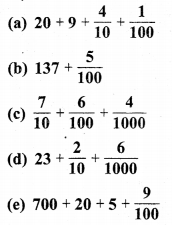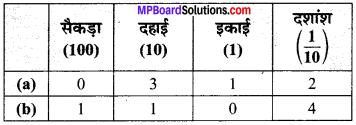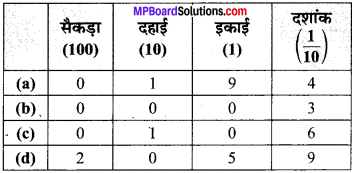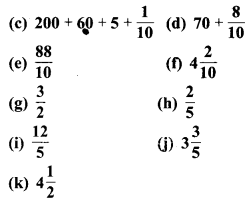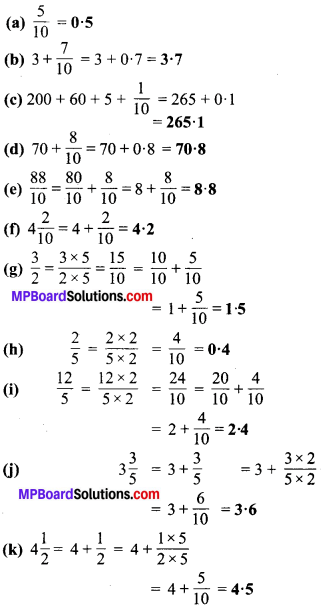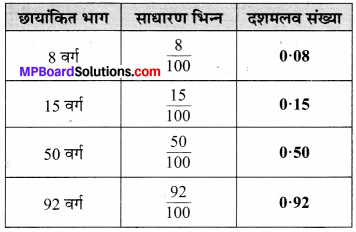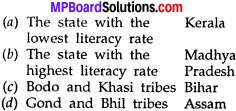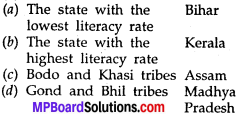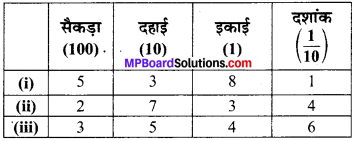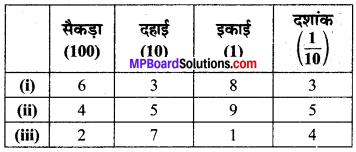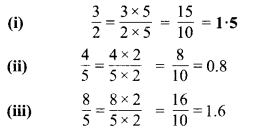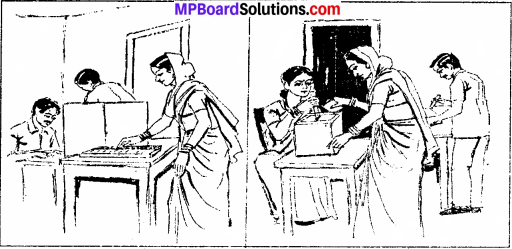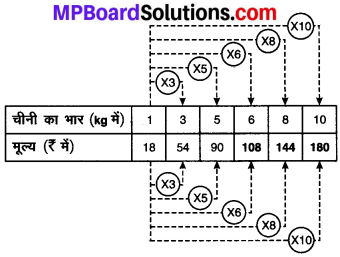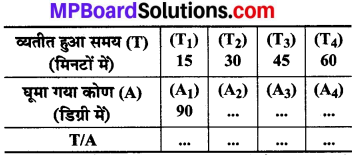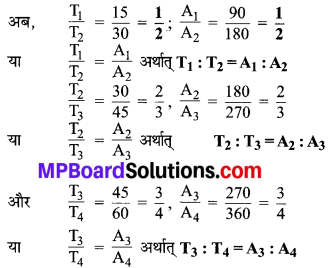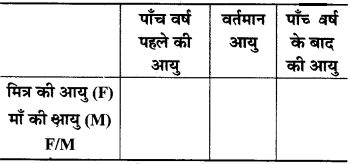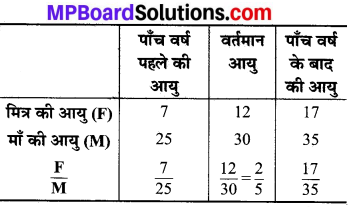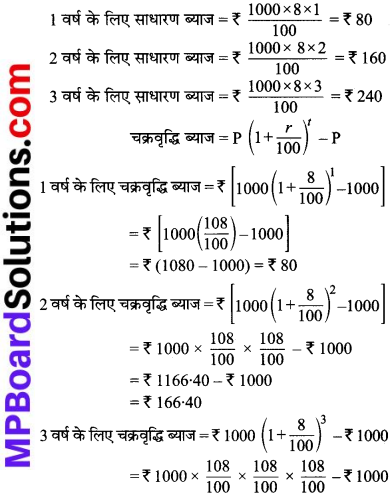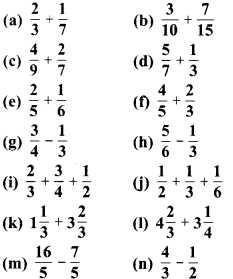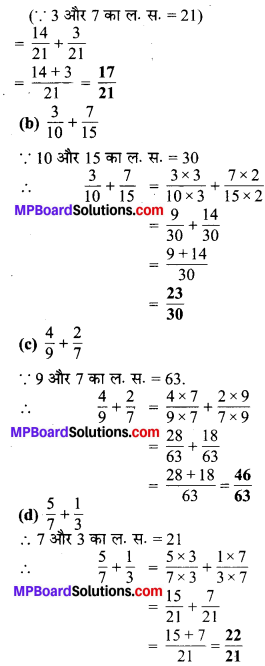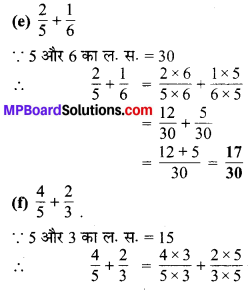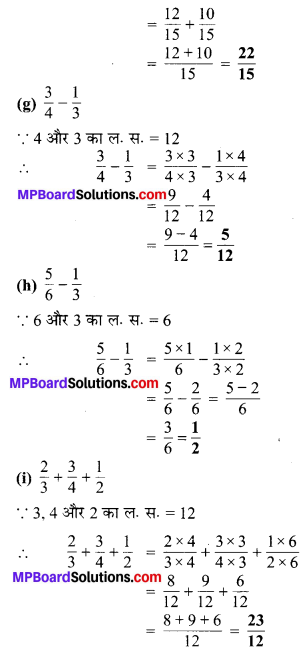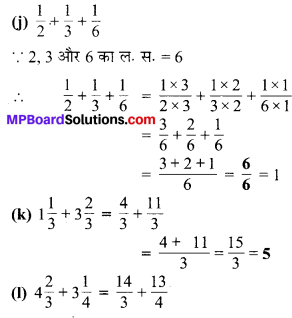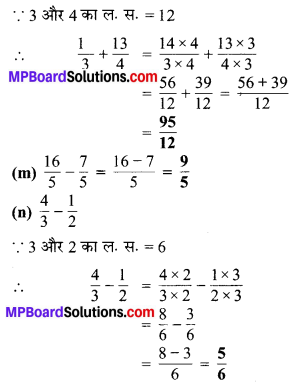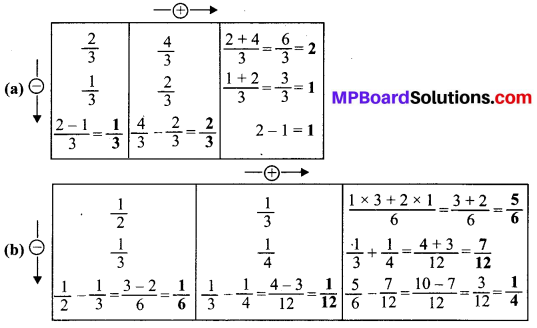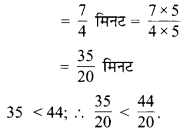MP Board Class 6th Maths Solutions Chapter 8 दशमलव Ex 8.3
पाठ्य-पुस्तक पृष्ठ संख्या # 190
प्रश्न 1.
कौन-सी बड़ी है ? कारण भी लिखिए
(a) 0.3 या 0.4
(b) 0.07 या 0.02
(c) 3 या 0.8
(d) 0.5 या 0.05
(e) 1.23 या 1.2
(f) 0.099 या 0.19
(g) 1.5 या 1.50
(h) 1.431 या 1.490
(i) 3.3 या 3.300
(j) 5.64 या 5.603
(k) पाँच ऐसे ही उदाहरण लिखकर उनमें से बड़ी संख्या ज्ञात कीजिए।
हल :
(a) 0.3 = \(\frac { 3 }{ 10 }\) और 0.4 = \(\frac { 4 }{ 10 }\)
∵ 0.3 का दशांश स्थान का अंक (3) 0.4 के दशांश स्थान के अंक (4) से छोटा है। :
∴0.3 < 0.4 अर्थात् 0.4 > 0.3
(b) 0.07 = \(\frac { 7 }{ 100 }\) और 0.02 = \(\frac { 2 }{ 100 }\)
∵ 0.07 की शतांश स्थान का अंक (7) 0.02 के शतांश स्थान के अंक (2) से बड़ा है। (7 > 2)
∴ 0.07 > 0.02
(c) 3 = 3 + \(\frac { 0 }{ 10 }\) और 0.8 = 0 + \(\frac { 8 }{ 10 }\).
∵ 3 का पूर्ण भाग 0.8 से बड़ा है। (3 > 0)
∴ 3 > 0.8
(d)

∵ 0.5 का दशांश स्थान का अंक (5) 0.05 के दशांश स्थान के अंक (0) से बड़ा है। (5 > 0)
∴ 0.5 > 0.05
(e)

∵ 1.23 का शतांश स्थान का अंक (3) 1.2 के शतांश स्थान के अंक (0) से बड़ा है। (3 > 0)
∴ 1.23 > 1.2
(f)

∵ 0.099 का दशांश स्थान का अंक (0) 0.19 के दशांश के अंक (1) से छोटा है। (0 < 1)
∴ 0.099 < 0.19 अर्थात् 0.19 > 0.099
(g)

∵ इस स्थिति में दोनों संख्या ओं का भाग पूर्णतः समान है।
∴ दोनों संख्याएँ समान हैं।
(h)

∵ 1.431 का शतांश स्थान का अंक (3) 1.490 के शतांश स्थान के अंक (9) से छोटा है। (3 > 9)
∴ 1.431 < 1.490. अर्थात् 1.490 > 1.431
(i)

∵ इस स्थिति में दोनों संख्याओं का भाग पूर्णतः समान है।
∴ 3.3 और 3.300 समान हैं।
(j)

∵ 5.64 का शतांश स्थान का अंक (4) 5.603 के शतांश स्थान के अंक (0) से बड़ा है। (4 > 0)
∴ 5.64 > 5.603
![]()
(k) उदाहरण
(i) 1.08 या 1.082
(ii) 1.0 या 0.99
(iii) 13.55 या 13.5
(iv) 4.03 या 4.30
(v) 11.21 या 11.12
यहाँ,
(i) 1.082 > 1.08,
(ii) 1.0 > 0.99,
(iii) 13.55 > 13.5,
(iv) 4.30 > 4.03,
(v) 11.21 > 11.12.
प्रयास कीजिए .
प्रश्न 1.
(i) 2 रुपये 5 पैसे और 2 रुपये 50 पैसों को दशमलव में लिखिए।
(ii) 20 रुपये 7 पैसे और 21 रुपये 75 पैसों को दशमलव में लिखिए।
हल :
(i) 2 रुपये 5 पैसे = 2 रुपये + \(\frac { 5 }{ 100 }\) रुपये
= 2 रुपये + 0.05 रुपये
= 2.05 रुपये
2 रुपये 50 पैसे = 2 रुपये + \(\frac { 50 }{ 100 }\) रुपये
= 2 रुपये + 0.50 रुपये
= 2.50 रुपये
(ii) 20 रुपये 7 पैसे = 20 रुपये + \(\frac { 7 }{ 100 }\) रुपये
= 20 रुपये + 0.07 रुपये
= 20.07 रुपये
21 रुपये 75 पैसे = 21 रुपये + \(\frac { 75 }{ 100 }\) रुपये
= 21 रुपये + 0.75 रुपये
= 21.75 रुपये
पाठ्य-पुस्तक पृष्ठ संख्या # 191
प्रयास कीजिए
प्रश्न 1.
क्या 4 मिमी को दशमलव का प्रयोग कर सेमी में लिख सकते हैं?
हल :
हाँ, 4 मिमी = \(\frac { 4 }{ 10 }\) सेमी = 0.4 सेमी
प्रश्न 2.
7 सेमी 5 मिमी को दशमलव का प्रयोग कर सेमी में कैसे लिखेंगे?
हल :
7 सेमी 5 मिमी = 7 सेमी + \(\frac { 5 }{ 10 }\) सेमी
= 7 सेमी + 0.5 सेमी
= 7.5 सेमी
प्रश्न 3.
क्या अब आप 52 मी को दशमलव का प्रयोग कर किमी में लिख सकते हैं? दशमलव का प्रयोग कर 340 मीटर को किमी में कैसे लिखेंगे ? 2008 मी को किमी में कैसे लिखेंगे?
हल :

![]()
प्रयास कीजिए
प्रश्न 1.
क्या आप 456 ग्रा को दशमलव का प्रयोग कर किग्रा में लिख सकते हैं ?
हल :
हाँ 456 ग्रा = \(\frac { 456 }{ 1000 }\) किग्रा = 0.456 किग्रा
प्रश्न 2.
2 कि 9 ग्राम को दशमलव का प्रयोग कर किग्रा में कैसे लिख सकते हैं ?
हल :
2 कि 9 ग्राम = 2 किग्रा + 9 ग्राम
= 2 किग्रा + \(\frac { 9 }{ 1000 }\) किग्रा
= 2 किग्रा + 0.009 किग्रा
= 2.009 किग्रा
